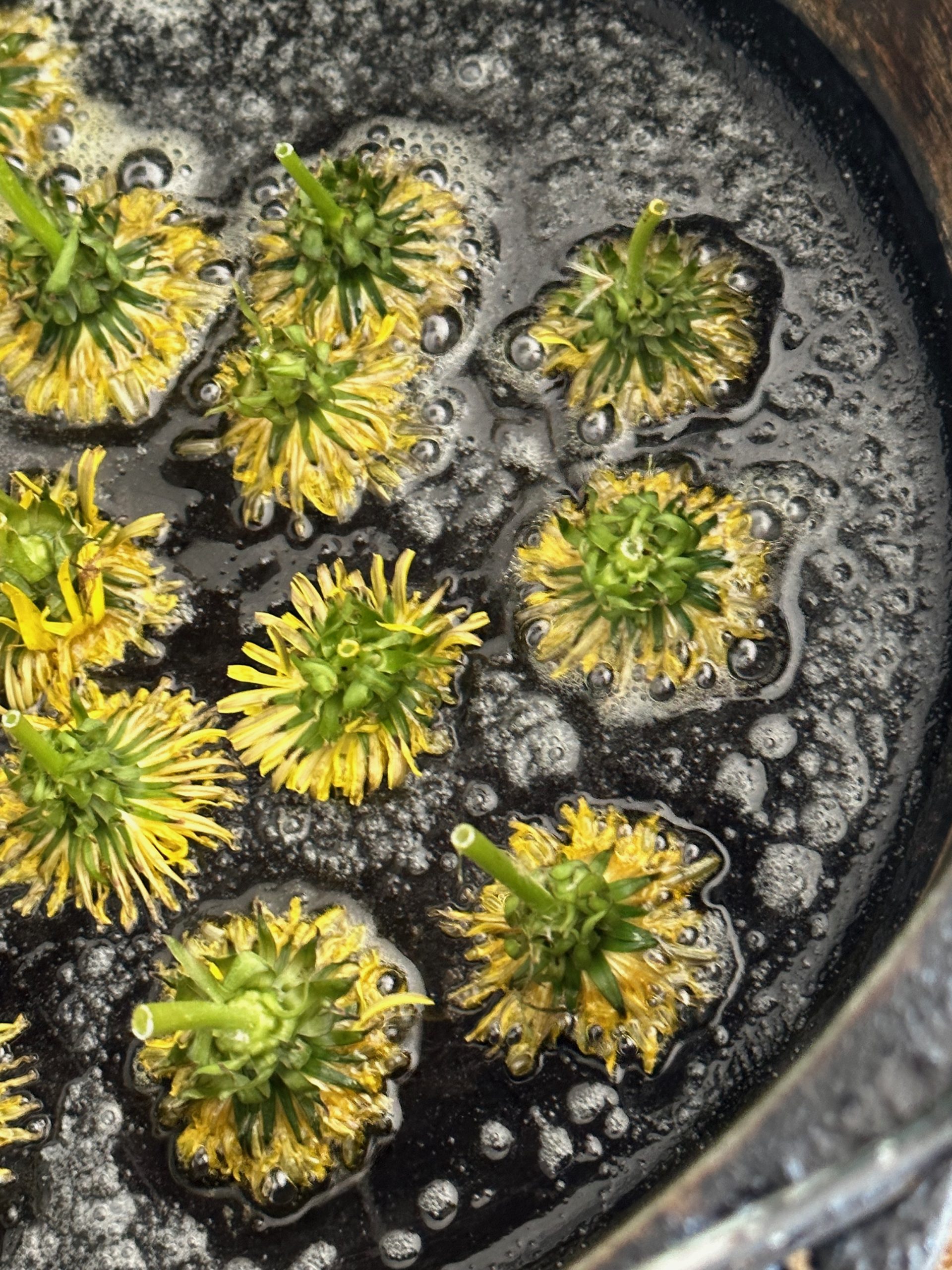The Dandelion Challenge
I make a point to eat a dandelion every day. The whole plant is edible, from the sunny top to the deep taproot, and all the stem, stalk and leaf in between. And there are ways to eat it that won’t contort your face with bitterness, but rather turn your frown upside down, inside out, round and round. Yes, dandelion can taste good, and be part of a delicious meal. It’s one of the most all-around healthy foods you can eat, rich in vitamins, fiber and many other nutrients.
The sunny flowers, fried in butter, oil or bacon, taste like extra floral artichokes. The buds have a meaty chewiness and are slightly sweet, with a sunny floral taste that’s a lot like a dandelion flower smells. Like summer, fresh cut grass. And dandelions.
The hollow flower stalks make great cocktail straws, bitters included. The roots can be roasted until chewy, crunchy or browned like coffee. The leaves are most of the plant. Raw and cooked, I have found ways to get hooked.
Native to northern Europe, dandelions specialize in colonizing disturbed areas, which humans specialize in creating. They have followed humans and their disturbances around the world, colonizing every continent except Antarctica. And while often labeled as weeds, they don’t hang out where they don’t belong.
In this little old growth forest patch near my house, where most of the plants and animals living there or passing through are native species and the ecosystem is roughly intact, there are no dandelions, except alongside the one trail through the grove. And you sure don’t want to eat those.
The best dandelion habitat is unsprayed, overgrown lawn, which is about as disturbed as a piece of land can get. Dandelions want to help steer the ecosystem toward diversity. And they can provide a diversity of nutrients and flavors to your diet. When you go out hunting, look for a place that wouldn’t have yellow snow in winter, if you know what I mean. Whether it’s the root, leaf, stalk or flower you seek, harvest them as cleanly as possible, bringing as little dirt home as possible.
In winter it will be more challenging to eat dandelion on the daily. It will involve more tea, and roots if you can jump on them before the plant flowers. That stuff needs to be gathered now, in these days of summertime, when the living is easy and the buds are open and high. Eat them fresh, stock them up for later.
Blanch and freeze. Dry the leaves and roots. Add flowers to a jar of pickled cucumbers for some quick pickled buds. They will close up but get chewy and tangy. Add leaves to sardine salad. Make dandelion infused oil, dandelion wine, dandelion BBQ, curry, potato salad, smoothie, olives and cheese in a rolled up leaf, a tapestry of daring dandelion tapas. Here are some do it yourself dandelion cookery ideas, one for every day of the week.
Sunday: Fried flowers
In a cast iron or omelet pan, fry flowers with the yellow sides in butter, oil or bacon, with garlic, salt, pepper and whatever else you can think of.
Monday: Raw leaves with grapefruit
Wash, dry and chop a bunch of raw leaves. Add onion and minced or mashed garlic. Dress with olive oil and lemon juice and season with salt or copious amounts of feta or both. Toss with peeled, cut and or separated grapefruit flesh.
Tuesday: Radikia: the famous Greek Dandelion dish
Blanch leaves in salted boiling water for about 60 seconds. Transfer immediately to cold water to chill. Then drain, squeeze and chop the dandelion. Dress with lemon juice, salt and olive oil
Wednesday Namul
This is a Korean style way to prepare dandelions. Blanch leaves as above, dress with a sauce made of minced garlic, sesame oil, cider vinegar, chile powder, a pinch of sugar and fish sauce or anchovy paste and salt to taste.
Thursday Roasted Roots
Excavate the root as gently as you can, loosening it as deeply as possible, ideally before it has flowered, after which the root can get woody. Scrub it clean and chop it, and roast slowly at 275 degrees until dark brown. Serve with salt, honey, chocolate, or as a coffee-flavored tea.
Friday Stalking Bitter bubbles
Go into the yard and pick the longest dandelion flower stalks you can. Pop off the flowers. Mix gin ‘n juice or tonic. Insert straw. Serve.
Saturday: Ramen
Tampopo means dandelion in Japanese. It’s also the name of a movie heroine, a hapless maker of mediocre ramen, in Tampopo, masterful Japanese comedy from 1985. The heroes attempt to teach her how to make ramen, but can’t. Drama and hilarity ensue. I only found out about it when I searched for dandelion ramen, to see if I invented it. But no. I am not the first person to add dandelion to a high-end ramen, like Nongshim or Sapporo Ichiban brands, with an egg cracked toward the end. Use any part of the plant, including leaves, even roots. As long as it’s clean, add it to the pot.
